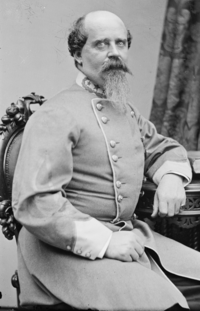Beverly Robertson: Difference between revisions
fix link and copyedit using AWB |
m →Civil War: grammar |
||
| Line 32: | Line 32: | ||
He was elected [[Colonel (United States)|colonel]] of the 4th Virginia Cavalry in August 1861 and served in the [[Valley Campaign]]. He was promoted to [[Brigadier General (CSA)|brigadier general]] on June 9, 1862.<ref name=Eicher>Eicher, p. 456.</ref> He fought at the [[Second Battle of Bull Run]] in August 1862, and the early part of the [[Maryland Campaign]] in September 1862. Prior to the [[Battle of Antietam]], he was ordered to North Carolina to recruit and train new cavalry [[regiment]]s. He participated in the [[Battle of New Bern]] in March 1863. |
He was elected [[Colonel (United States)|colonel]] of the 4th Virginia Cavalry in August 1861 and served in the [[Valley Campaign]]. He was promoted to [[Brigadier General (CSA)|brigadier general]] on June 9, 1862.<ref name=Eicher>Eicher, p. 456.</ref> He fought at the [[Second Battle of Bull Run]] in August 1862, and the early part of the [[Maryland Campaign]] in September 1862. Prior to the [[Battle of Antietam]], he was ordered to North Carolina to recruit and train new cavalry [[regiment]]s. He participated in the [[Battle of New Bern]] in March 1863. |
||
During the [[Gettysburg Campaign]], he commanded a brigade of two North Carolina cavalry regiments primarily assigned to scout for [[Robert E. Lee]]. At the [[Battle of Brandy Station]], his men failed to significantly delay a [[Union Army|Union]] column |
During the [[Gettysburg Campaign]], he commanded a brigade of two North Carolina cavalry regiments primarily assigned to scout for [[Robert E. Lee]]. At the [[Battle of Brandy Station]], his men failed to significantly delay a [[Union Army|Union]] column approaching Brandy Station from the southeast. He fought in [[J.E.B. Stuart]]'s delaying actions in the [[Loudoun Valley]] at [[Battle of Middleburg|Middleburg]] and [[Battle of Upperville|Upperville]]. His men helped cover Lee's [[Retreat from Gettysburg|retreat]] following the [[Battle of Gettysburg]], but suffered severe losses during the campaign. |
||
He was assigned in October 1863 to command the Second Military District, which encompassed South Carolina, Georgia, and Florida. He helped defend [[Charleston, South Carolina|Charleston]] from enemy attack. Robertson served in the [[Carolinas Campaign]] and surrendered with Gen. [[Joseph E. Johnston]]. |
He was assigned in October 1863 to command the Second Military District, which encompassed South Carolina, Georgia, and Florida. He helped defend [[Charleston, South Carolina|Charleston]] from enemy attack. Robertson served in the [[Carolinas Campaign]] and surrendered with Gen. [[Joseph E. Johnston]]. |
||
Revision as of 21:54, 14 August 2009
Beverly Holcombe Robertson | |
|---|---|
 Portrait of Robertson ca. 1863 | |
| Allegiance | United States of America Confederate States of America |
| Service | United States Army Confederate States Army |
| Years of service | 1849-1861 (USA) 1861-1865 (CSA) |
| Rank | Captain (USA) Brigadier General (CSA) |
| Commands | Robertson's Brigade |
| Battles / wars | American Civil War |
| Other work | Insurance Businessman |
Beverly Holcombe Robertson (June 5, 1827 – December 12, 1910) was a cavalry officer in the United States Army on the Western frontier and a Confederate general during the American Civil War.
Early life
Robertson was born on a plantation in Amelia County, Virginia. He received an appointment to the United States Military Academy and graduated in 1849. Assigned to the 2nd U.S. Dragoons as a second lieutenant, he attended the cavalry school at Carlisle Barracks. He then served on the frontier at various outposts in New Mexico Territory, Kansas Territory, and Nebraska Territory, fighting at various times with the Apache and Sioux. Reassigned to the 5th U.S. Cavalry, Robertson was promoted to first lieutenant. He became adjutant of the regiment while serving in Utah Territory and soon was elevated to acting assistant adjutant general for the Department of Utah. He was promoted to captain in March 1861, but soon accepted a captaincy in the Confederate Adjutant General's Department.
Civil War
He was elected colonel of the 4th Virginia Cavalry in August 1861 and served in the Valley Campaign. He was promoted to brigadier general on June 9, 1862.[1] He fought at the Second Battle of Bull Run in August 1862, and the early part of the Maryland Campaign in September 1862. Prior to the Battle of Antietam, he was ordered to North Carolina to recruit and train new cavalry regiments. He participated in the Battle of New Bern in March 1863.
During the Gettysburg Campaign, he commanded a brigade of two North Carolina cavalry regiments primarily assigned to scout for Robert E. Lee. At the Battle of Brandy Station, his men failed to significantly delay a Union column approaching Brandy Station from the southeast. He fought in J.E.B. Stuart's delaying actions in the Loudoun Valley at Middleburg and Upperville. His men helped cover Lee's retreat following the Battle of Gettysburg, but suffered severe losses during the campaign.
He was assigned in October 1863 to command the Second Military District, which encompassed South Carolina, Georgia, and Florida. He helped defend Charleston from enemy attack. Robertson served in the Carolinas Campaign and surrendered with Gen. Joseph E. Johnston.
Postbellum career
After the war, Robertson moved to Washington, D.C., and worked in the insurance business for several decades. He is buried in Robertson Cemetery near Scott's Fork, Amelia County, Virginia.[1]
See also
References
- Eicher, John H., and Eicher, David J., Civil War High Commands, Stanford University Press, 2001, ISBN 0-8047-3641-3.
- Text from Clement Evans' biography of Robertson
Notes
External links
- Beverly Robertson at Find a Grave Retrieved on 2008-02-13
